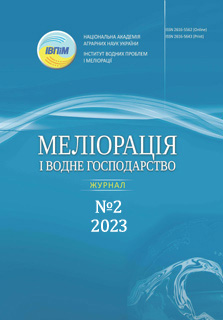EVALUATION OF POSSIBILITIES FOR USING ELECTROCHEMICALLY ACTIVATED WATER FOR IRRIGATION
Abstract
In order to check the possibility of using electrochemically activated water (ECHAW) in irrigation, a study was conducted to determine the influence of anolyte on biological pollutants of wastewater and the reduction of water mineralization by electrochemical activation, as well as the influence of catholyte and anolyte on the germination of seeds of cereal crops, the development of seedlings of pepper and tomato, and the yield of tomato. The research was conducted in laboratory conditions on two varieties of pepper and four varieties of tomato. ECHAW was obtained using laboratory water activators of our own production. Wastewater samples were taken at the Bortnychy wastewater aeration station in Kyiv. Experiments were carried out using vegetation containers of various types and one-time bacteriological tests. It was found that by electrochemical activation of mineralized water it is possible to reduce the level of its total mineralization by more than 50% and, with an anolyte, to destroy disease-causing bacteria in wastewater. The use of ЕCHAW accelerates the germination of seeds of cereal crops. On the 3rd day of germination, wheat grain germinated using EHCAW has a 9% longer root length than the grain germinated under the same conditions using non-activated water. Wheat grain germinated using EHCAW also has 33% longer sprouts. The growth rate when irrigated with activated water, depending on the variety of tomato plants, increases by 9,8-25,2%, the increase in stem diameters was equal to 11,3-22,4%. The yield of tomatoes when irrigated with activated water is 12,6-15,8% higher than in the case of irrigation by ordinary water, the size of the fruits is 15,4-25,1% larger. The results of the conducted research indicate the possibility and perspective of using EHCAW to increase the yield of crops under irrigation and improving the quality of drainage and wastewater by reducing their mineralization and providing their disinfection.
References
2. Qing, G., Anari, Z., Foster, S.L., Matlock, M., Thoma, G., & Greenlee, L.F. (2021). Electrochemical disinfection of irrigation water with a graphite electrode flow cell. Water, 93 (4), 535-548. Retrieved from: https://onlinelibrary.wiley.com/doi/10.1002/wer.1456.
3. Qing, G., Abolhassani, M., Daneshpour, R., Foster, S.L., Matlock, M., Thoma, G., & Greenlee, L.F. (2021). Disinfection of Irrigation Water Using Titanium Electrodes. Journal of The Electrochemical Society, 168 (6). DOI: https://doi.org/10.1149/1945-7111/ac0943
4. Reijnen, J. (2021). The use of ECA-water for water disinfection in horticulture. Royal Brinkman. Retrieved from: https://royalbrinkman.com/news/eca-water-alternative-to-chemical-disinfectants
5. John, W., & Bartok, JR. (2016). Disinfecting recycled irrigation water. Greenhouse management. Retrieved from: https://www.greenhousemag.com/article/disinfecting-recycled-irrigation-water/.
6. Stolyarenko, H.S., Azizov, R.O., & Tupitsky, B.I. (2019). Elektroaktyvatsiyne ochyshchennya mineralizovanykh vod [Electroactivation treatment of mineralized water]. Bulletin of Cherkasy State Technological University, 3, 98-107. [in Ukrainian]
7. Lysytsia, A.V., & Mygra, Y.M. (2021). Elektrokhimichna aktyvatsiya vody, yak alʹternatyva tradytsiynym dezinfektantam [Electrochemical activation of water as an alternative to traditional disinfectants]. About modern problems in science & ways to solve them: Abstracts of XII International Scientific & Practical Conference. Graz, Austria, 19-21. [in Ukrainian]
8. Abdullaev, M.T., Zakirov, K.R., & Khaitov, B.A. (2023). Production of electrochemically activated water in the composition of microelements & use in pre-sowing treatment of vegetable seeds. Science & Innovation International Scientific Journal, vol. 2, iss. 6, 161-165. DOI: 10.5281/zenodo.8101476
9. Tsokur, D.S. (2013). Uluchsheniye kachestva regulirovaniya kislotnosti pochvy na osnove elektroaktivatora vody pri vyrashchivanii tomatov v usloviyakh zakrytogo grunta [Improvement of soil acidity regulation based on water electroactivator in tomato indoor growing]. Extended abstract of the Ph.D. thesis. Krasnodar. [in Russian]
10. Semenenko, S.Y., Belitskaya, M.N., & Likholetov, S.M. (2013). Fitosanitarnoye ozdorovleniye zernovykh i ovoshchnykh kul'tur s pomoshch'yu elektrokhimicheski aktivirovannoy vody [Phytosanitary improvement of grain & vegetable crops using electrochemically activated water]. Successes of modern natural science, 1, 78-82. [in Russian]
11. Chushkina, E. I., Semenenko, S. Ya., Lytov, M. N., & Chushkin, A. N. (2015). Mekhanizm biologicheskogo deystviya i opyt primeneniya elektrokhimicheski aktivirovannykh vodnykh sred v sel'skom khozyaystve [Mechanism of biological action & experience in the use of electrochemically activated aqueous media in agriculture]. Land and Reclamation Problems, 4(20), 170–185. [in Russian]
12. Chushkina, E.I. (2014). Tekhnologiya primeneniya elektrokhimicheski aktivirovannoy vody pri kapel'nom oroshenii tomatov [The technology of using electrochemically activated water for drip irrigation of tomatoes]. Extended abstract of the Ph.D. thesis. Volgograd. [in Russian]
13. Amcheslavsky, O. V. (2011). Razrabotka tekhnologii orosheniya sakharnoy kukuruzy s ispol'zovaniyem optimizirovannykh sostavov aktivirovannykh rastvorov [Development of sweet corn irrigation technology using optimized compositions of activated solutions]. Extended abstract of the Ph.D. thesis. Volgograd. [in Russian]
14. Chushkin, O.M. (2014). Teoreticheskoye i eksperimental'noye obosnovaniye algoritma proyektirovaniya sistem kapel'nogo orosheniya s modulem elektrokhimicheskoy aktivatsii vody [Theoretical & experimental substantiation of the design algorithm for drip irrigation systems with a module for electrochemical activation of water]. Extended abstract of the Ph.D. thesis. Volgograd. [in Russian]
15. Semenenko, S. Ya., Belitskaya, M. N., & Likholetov, S. M. (2012). Ispol'zovaniye elektrokhimicheski aktivirovannoy vody dlya povysheniya urozhaynosti kartofelya [Use of electrochemically activated water to increase potato yield]. Agrarian Science, 5, 21–23. [in Russian]
16. Chushkina, E. I., Semenenko, S. Ya., Lytov, M. N., & Chushkin A. N. (2015). Mekhanizm biologicheskogo deystviya i opyt primeneniya elektrokhimicheski aktivirovannykh vodnykh sred v sel'skom khozyaystve [Mechanism of biological action & experimental application of electrochemically activated water media in agriculture]. Scientific Journal of Reclamation Problems, 4(20), 170–185. [in Russian]
17. Semenenko, S. Ya., Lytov, M. N., Chushkina, E. I., & Chushkin, A. N. (2014). Produktivnost' tomatov pri kapel'nom oroshenii s ispol'zovaniyem elektrokhimicheski aktivirovannoy vody [Productivity of tomatoes under drip irrigation using electrochemically activated water]. Melioratsiya i gidrotekhnika [Reclamation and hydraulic engineering], (2 (14)), 1-14. [in Russian]


